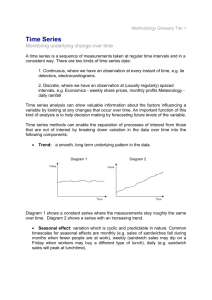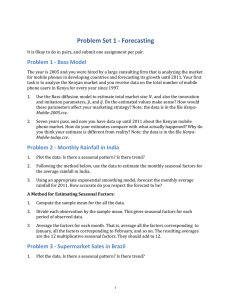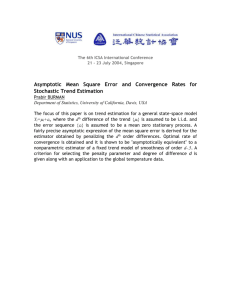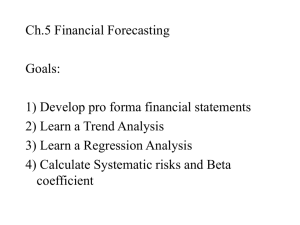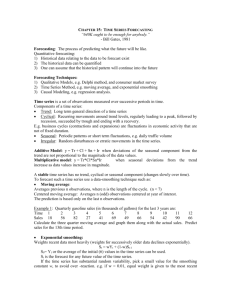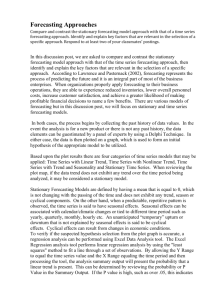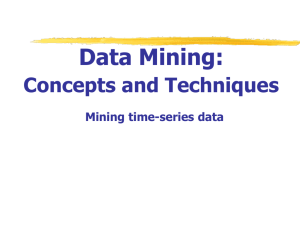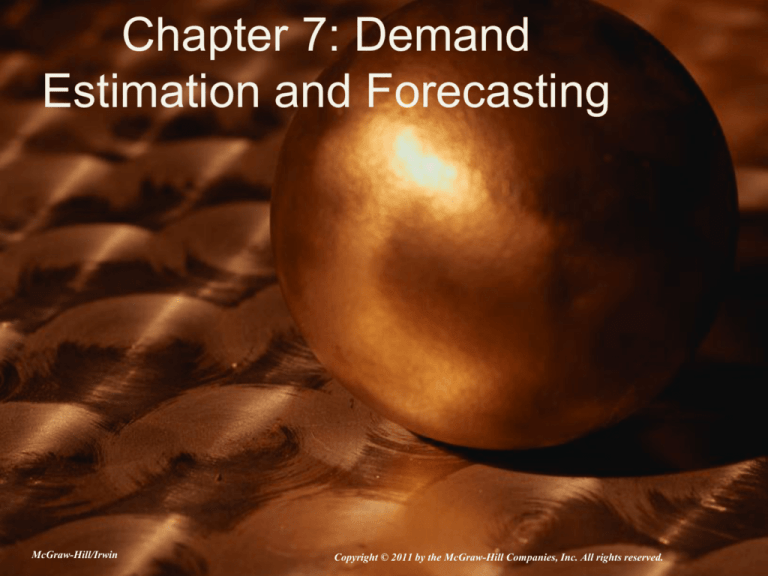
Chapter 7: Demand
Estimation and Forecasting
McGraw-Hill/Irwin
Copyright © 2011 by the McGraw-Hill Companies, Inc. All rights reserved.
Direct Methods of Demand Estimation
• Consumer interviews
• Range from stopping shoppers to speak with
them to administering detailed questionnaires
7-2
Direct Methods of Demand Estimation
• Potential problems with consumer
interviews
• Selection of a representative sample, which is a
sample (usually random) having characteristics that
accurately reflect the population as a whole
• Response bias, which is the difference between
responses given by an individual to a hypothetical
question and the action the individual takes when
the situation actually occurs
• Inability of the respondent to answer accurately
7-3
Direct Methods of Demand Estimation
• Market studies & experiments
• Market studies attempt to hold everything
constant during the study except the price of
the good
• Lab experiments use volunteers to simulate
actual buying conditions
• Field experiments observe actual behavior of
consumers
7-4
Empirical Demand Functions
• Demand equations derived from actual
market data
• Useful in making pricing & production
decisions
7-5
Empirical Demand Functions
• In linear form, an empirical demand function
can be specified as
Q a bP cM dPR
where Q is quantity demanded, P is the price of the good or
service, M is consumer income, & PR is the price of some
related good R
7-6
Empirical Demand Functions
Q a bP cM dPR
• In linear form
• b = Q/P
• c = Q/M
• d = Q/PR
• Expected signs of coefficients
• b is expected to be negative
• c is positive for normal goods; negative for inferior goods
• d is positive for substitutes; negative for complements
7-7
Empirical Demand Functions
Q a bP cM dPR
• Estimated elasticities of demand are
computed as
P
ˆ
ˆ
Eb
Q
M
ˆ
ˆ
EM c
Q
PR
ˆ
ˆ
E XR d
Q
7-8
Nonlinear Empirical Demand
Specification
• When demand is specified in log-linear
form, the demand function can be written as
Q aP M P
b
c
d
R
• To estimate a log-linear demand function,
covert to logarithms
lnQ lna b ln P c ln M d ln PR
• In this form, elasticities are constant
ˆ bˆ
E
ˆ cˆ
E
M
ˆ dˆ
E
XR
7-9
Demand for a Price-Setter
• To estimate demand function for a pricesetting firm:
• Step 1: Specify price-setting firm’s demand
function
• Step 2: Collect data for the variables in the
firm’s demand function
• Step 3: Estimate firm’s demand using
ordinary least-squares regression (OLS)
7-10
Time-Series Forecasts
• A time-series model shows how a timeordered sequence of observations on a
variable is generated
• Simplest form is linear trend forecasting
• Sales in each time period (Qt ) are assumed to
be linearly related to time (t)
Qt a bt
7-11
Linear Trend Forecasting
• Use regression analysis to estimate
values of a and b
ˆ aˆ bt
ˆ
Q
t
• If b > 0, sales are increasing over time
• If b < 0, sales are decreasing over time
• If b = 0, sales are constant over time
• Statistical significance of a trend is
determined by testing b̂ or by examining
the p-value for b̂
7-12
A Linear Trend Forecast
(Figure 7.1)
Q
Estimated trend line
Q̂ 2009
12
Q̂ 20047
Sales
t
2012
2007
2006
2005
2004
2003
2002
2001
2000
1999
1998
1997
7-13
Forecasting Sales for Terminator
Pest Control (Figure 7.2)
7-14
Seasonal (or Cyclical) Variation
• Can bias the estimation of parameters in
linear trend forecasting
• To account for such variation, dummy
variables are added to the trend equation
• Shift trend line up or down depending on the
particular seasonal pattern
• Significance of seasonal behavior determined by
using t-test or p-value for the estimated
coefficient on the dummy variable
7-15
Sales with Seasonal Variation
(Figure 7.3)
2004
2005
2006
2007
7-16
Dummy Variables
• To account for N seasonal time periods
• N – 1 dummy variables are added
• Each dummy variable accounts for one
seasonal time period
• Takes value of one (1) for observations that
occur during the season assigned to that
dummy variable
• Takes value of zero (0) otherwise
7-17
Effect of Seasonal Variation
(Figure 7.4)
Qt
Qt = a′ + bt
Sales
Qt = a + bt
a′
c
a
t
Time
7-18
Some Final Warnings
• The further into the future a forecast is made,
the wider is the confidence interval or region
of uncertainty
• Model misspecification, either by excluding
an important variable or by using an
inappropriate functional form, reduces
reliability of the forecast
7-19
Some Final Warnings
• Forecasts are incapable of predicting sharp
changes that occur because of structural
changes in the market
7-20


